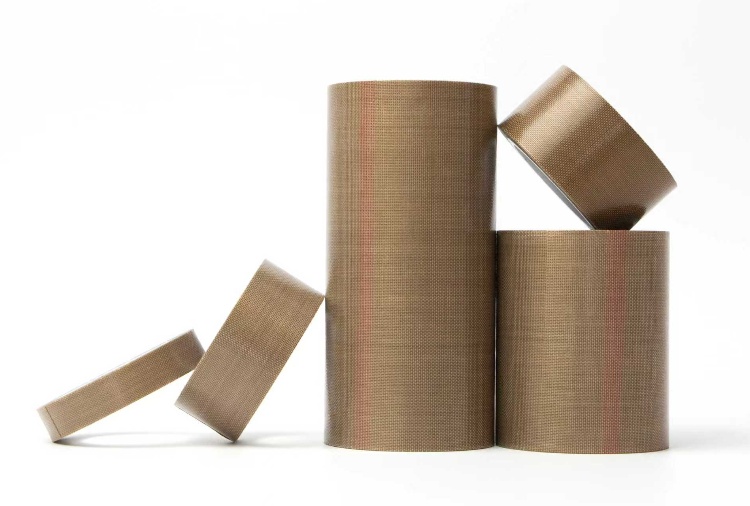Teflon PTFE Coated Fiberglass Tape
Teflon tape has the characteristics of high temperature resistance, corrosion resistance, insulation, and non-stickiness, and is widely used in industry, electronics, pipeline sealing and other fields.
Production Process Flow
From raw materials to finished product, every step is rigorously controlled to ensure consistent and reliable performance.
The process starts with PTFE (polytetrafluoroethylene) fine powder. This powder is mixed with a lubricant, often a type of mineral spirit or naphtha, to create a paste-like consistency. This makes the powder workable for the next steps.
The lubricated paste is then compressed under pressure into a solid, cylindrical shape called a billet. This compacts the powder and prepares it for extrusion.
The billet is forced (extruded) through a die, emerging as a long, continuous rod or tube. This is the first step in shaping the material.
- It creates a very thin, uniform film.
- It aligns the PTFE molecules in the direction of the stretch, which gives the tape its characteristic strength and prevents it from breaking easily when pulled.
- First, the lubricant added in step one is completely evaporated.
- Second, the temperature is raised even higher (to the sintering point) to fuse the PTFE particles together into a solid, non-porous, and strong film.

PTFE Fiberglass Adhesive Tape
Teflon PTFE Coated Fiberglass Tape Series Specification Sheet
| Item | 1013J Adhesive Tape | 1018JT Adhesive Tape | 1017JT Adhesive Tape | 1019JT Adhesive Tape | 1025J Thick Adhesive Tape | 1028 Smooth Adhesive Tape | 1030J Adhesive Tape |
|---|---|---|---|---|---|---|---|
| Substrate Thickness | 0.06mm (±0.01) | 0.08mm (±0.01) | 0.095mm (±0.01) | 0.095mm±0.01 | 0.15mm (±0.01) | 0.18mm±0.01 | 0.2mm ±0.01mm |
| Emulsion System | PTFE Tetrafluoro | PTFE Tetrafluoro | PTFE Tetrafluoro | PTFE Tetrafluoro | PTFE Tetrafluoro | PTFE Tetrafluoro | PTFE Tetrafluoro |
| Coating Thickness | 0.02mm | 0.03mm | 0.03mm | – | 0.05mm | 0.05mm | 0.05mm |
| High-temperature Cloth Thickness | 0.08mm (±0.01) | 0.11mm (±0.01) | 0.125mm (±0.01) | 0.13mm±0.01 | 0.2mm (±0.01) | 0.23mm±0.01 | 0.25mm±0.01mm |
| Adhesive Series | Organic Silicone Pressure-sensitive Adhesive | Organic Silicone Pressure-sensitive Adhesive | Organic Silicone Pressure-sensitive Adhesive | Organic Silicone Pressure-sensitive Adhesive | Organic Silicone Pressure-sensitive Adhesive | Organic Silicone Pressure-sensitive Adhesive | Organic Silicone Pressure-sensitive Adhesive |
| Adhesive Coating | 0.05mm | 0.05mm | 0.05mm | 0.05mm | 0.05mm | 0.05mm | 0.05mm |
| Total Thickness | 0.13mm (±0.01) | 0.16mm (±0.01) | 0.17mm (±0.01) | 0.18mm±0.01 | 0.25mm (±0.01) | 0.28±0.01mm | 0.3±0.01mm |
| Elongation Coefficient | 5% | 5% | 5% | 5% | 5% | 5% | 5% |
| Surface Friction Coefficient | – | – | – | 0.05 – 0.1 | 0.05-0.1 | 0.05-0.1 | 0.05-0.1 |
| Insulation Coefficient | ≥10¹² Ohms | ≥10¹² Ohms | ≥10¹² Ohms | ≥10¹² Ohms | ≥10¹² Ohms | ≥10¹² Ohms | ≥10¹² Ohms |
| Adhesion Strength (to steel) | 8-11N/25mm | 9-12N/25mm | 9-12N/25mm | 10 – 15N/25mm | 10-15N/25mm | 10-15N/25mm | 10-15N/25mm |
| Dielectric Index | 2.5KV | 2.5KV | 2.5KV | 2.5KV | 2.5KV | 2.5KV | 2.5KV |
| Test Method | 260° Oven Tensile Test | 260° Oven Tensile Test | 260° Oven Tensile Test | 280° Oven Tensile Test | – | – | – |
Technical Breakdown: Teflon Tape Usage
Understanding the correct application and inherent properties of Teflon tape is crucial for achieving a leak-proof seal. Misunderstanding its function can lead to joint failure.
Functions, Uses, and Applications
Teflon tape is an indispensable material for sealing threaded pipe joints. Its core function is to create a reliable, leak-proof seal in a wide variety of fluid and gas systems.
Quality Standards & Certifications
Jiujiang Leadcomp Co., Ltd. is committed to delivering the highest quality products, a promise backed by strict internal standards and authoritative third-party certifications.
